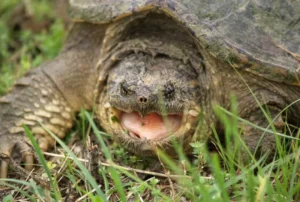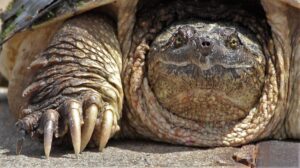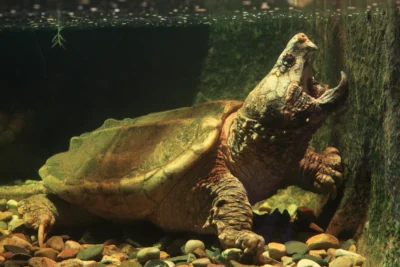Are snapping turtles endangered? This question prompts a critical exploration into the conservation status of these ancient reptiles. Snapping turtles, renowned for their rugged demeanor and formidable bite, inhabit diverse aquatic habitats across the globe.
However, their populations face multifaceted threats stemming from habitat loss, pollution, and overexploitation. In this article, we delve into the current status of snapping turtles, shedding light on their ecological significance and the challenges they confront in an ever-changing environment.
Are Snapping Turtles Endangered?

Snapping turtles are not currently considered endangered as a species overall, but their populations face various threats, and certain species and populations may be at risk.
There are several species of snapping turtles, with the common snapping turtle (Chelydra serpentina) being the most widespread. While they are not endangered as a whole, localized populations may face threats due to habitat loss, pollution, illegal hunting, and road mortality. These factors can significantly impact the survival of snapping turtles in specific regions.
Additionally, some species of snapping turtles, such as the alligator snapping turtle (Macrochelys temminckii), are classified as threatened or of conservation concern due to habitat destruction, overharvesting, and collection for the pet trade. Conservation efforts are in place to protect these vulnerable species and their habitats.
Overall, while snapping turtles are not currently endangered globally, conservation efforts are essential to monitor and protect their populations, especially in areas where they face significant threats.
What Factors Determine Endangerment?
The endangerment status of a species is determined by a combination of biological, ecological, and anthropogenic (human-related) factors. Here are some key factors that contribute to a species being classified as endangered:
- Habitat Loss and Degradation: Destruction, fragmentation, and alteration of natural habitats can have a significant impact on species populations. Loss of suitable habitat can lead to reduced food availability, limited breeding sites, and increased competition with other species.
- Overexploitation: Overhunting, overfishing, and illegal trade can deplete populations of species to unsustainable levels. When a species is harvested faster than it can reproduce, its populations can decline rapidly.
- Pollution: Pollution of air, water, and soil can directly harm species or disrupt their habitats. Chemical pollutants, such as pesticides, heavy metals, and oil spills, can poison organisms, affect reproduction, and alter ecosystems.
- Climate Change: Alterations in temperature, precipitation patterns, sea levels, and extreme weather events associated with climate change can have profound impacts on species distributions, behaviors, and interactions with other organisms. Species with narrow habitat requirements or limited ability to adapt may face increased risk of extinction.
- Invasive Species: Introduction of non-native species into ecosystems can disrupt native species populations and ecosystems. Invasive species may outcompete native species for resources, prey on them, or introduce diseases to which they have no resistance.
- Genetic Factors: Low genetic diversity within populations can increase susceptibility to diseases, reduce reproductive success, and limit adaptability to changing environmental conditions. Small, isolated populations are particularly vulnerable to genetic issues.
- Human Disturbance: Activities such as urbanization, agriculture, infrastructure development, and recreational pursuits can directly disturb habitats, fragment landscapes, and disturb wildlife populations.
- Legal Protection: The absence or inadequacy of legal protections for species and their habitats can leave them vulnerable to exploitation, habitat destruction, and other threats.
When a species experiences significant negative impacts from one or more of these factors, conservationists and scientists may classify it as endangered or threatened, prompting conservation actions to protect and recover its populations.
What Are the Main Threats to Snapping Turtles?


